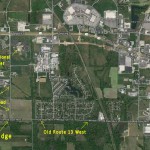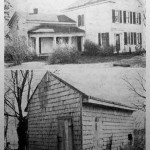Bainbridge, in section 16, West Marion Township, was the first place in the county where people gathered into a village. A buffalo trail and an Indian camp frequented until 1813 led the settlers to this spot in Phelps prairie. The earliest trails through the county crossed at this point, the Fort Massac and Lusk’s ferry (Golconda) trails joined before they reached Bainbridge, and the Shawneetown trail met the two southern routes there, to go on to Kaskaskia. As soon as there were settlements in the center of the state, travel from Frankfort to Jonesboro passed through Bainbridge, and the route was made a post road by 1839. Frankfort to Bainbridge was fifteen miles by stage.
Such a natural trading point was sure to develop commercially, and the first store in Williamson County opened for business at Bainbridge in 1818. Mr. Kipps was the proprietor, and his stock had to be brought by horseback or man-pack from the Ohio or the Mississippi. Storekeeper Thompson opened up about three years later, and sold coffee at 75c a pound and calico at 50c a yard. Warrenton K. Spiller and then Samuel Cripps took a hand as merchants at Bainbridge.
A post office was established February 18, 1837, when residents began to complain of the inconvenience caused by going all the way to Frankfort for their mail. Allen Bainbridge was the first postmaster, and the office was undoubtedly his name-sake. Allen and John Bainbridge were outstanding citizens, leaders in the organization of the county. The former was elected to the legislature with Willis Allen to secure the county division, the latter was the first county clerk, and clerk of Crab Orchard voting district in 1839.
Bainbridge served as Williamson County’s first county seat during the months between division and actual building. County officers were elected in September, 1839. The law governing the division provided for William Norris, Sterling Hill, and John T. Davis to meet at Bainbridge and tally the votes. The commissioners to locate the permanent county seat met at Bainbridge to be sworn and proceed with their duties.
At Bainbridge the first county officers received whatever corresponded to their certificates of election. Sterling Hill and Frederick F. Duncan were county commissioners, to serve with Cyrus Campbell of Eight Mile prairie, a commissioner of Franklin county specifically directed to retain his office. John Bainbridge was clerk, John D. Sanders, sheriff, and John Davis, treasurer. They took up their duties when the county court met at Marion October 7, 1839.
With the new county seat a commercial rival so few miles away, Bainbridge still continued to thrive. What else could it have done, with such men as Samuel Dunaway and James T. Goddard among its merchants? Samuel Dunaway (1809-1876) ran away from the master to whom he had been apprenticed as an orphan in North Carolina, came to Bainbridge, and began work as a hatter. His hat shop, primitive as it was, represented the first manufacture in the county other than mills. Bainbridge had a tan yard, run by the brothers Frank and John Brown about 1850. The former was a son-in-law of Samuel Dunaway after 1852. They marketed their leather in St. Louis, hauling it overland and returning with a load of goods for Bainbridge merchants.
Dr. George L. Owen (1813-1883) began practice at Bainbridge in 1840, and served as postmaster there thirty-nine years. His home, a beautiful house that reflects the architectural ideas of his native Massachusetts, still stands (in 1939) on (old) route 13 to mark the vanished glory of old Bainbridge. The doctor’s only son, Alonzo N. Owen (1842-1879), was born at Bainbridge and served the county as sheriff after five years Civil war service in the United States army.
Bainbridge had its share of groceries, as the tavern of those days was called. The Franklin county commissioners’ court in 1839 licensed John Bainbridge’s house, where Ethelbert C. Spiller was a partner. F. F. Duncan and William T. Turner had permission to keep a house of entertainment at Bainbridge. Mr. Turner was postmaster for a while, and Mr. Duncan became a member of the Williamson county commissioners’ court nine months later. That court appointed Mr. Turner the first school commissioner. D. Dempsey, John Davis, and James T. Goddard also provided liquid refreshments, so necessary after the regular battalion drills of the militia that were held at Bainbridge. At a company muster in 1845, the militiamen imbibed too much Dutchman’s courage, and squared off for a general fight. Just as they fell to, lightning struck a cottonwood tree nearby and scared every thought but getting away out of their minds.
Bainbridge also looked to the future, and was the first place in the county to provide its children a better education than reading, writing, and ciphering to the rule of three. Professor Bugg opened a school of higher grade in 1840, one year after the legislature incorporated Bainbridge academy. Nehemiah A. Hunt taught at Bainbridge until he began his ministry of the Presbyterian Church at Marion in 1848. Dr. James Hayton (1815-1904), for whom Hayton School is named, taught four years at Bainbridge while he practiced medicine with Doctor Owen. Doctor Hayton’s son William, who became the father of Mayor Wes Hayton of Carterville, was born at Bainbridge.
Bainbridge Missionary Baptist church was organized May 15, 1865 and held its meetings in the schoolhouse. Elder T. W. Chamness was the first pastor, and served many years. He, with Elders D. S. Crain and W. B. Chamness, and Deacons Peter Miller and Henry Frey, formed the first council elected by thirteen original members.
When the Carbondale and Shawneetown railroad built its line to Marion in 1871, the president of the road, Samuel Dunaway, made sure that his home town of Bainbridge was a station on the route. But Mr. Dunaway followed his former partner, James T. Goddard, to Marion in 1872. Bainbridge began to fade. The Illinois Central, successor to the Carbondale and Shawneetown, has only a flag stop at Bainbridge.
The post office was discontinued October 24, 1881 and by 1887 historians recorded that only four dwellings remained standing in Bainbridge. Now we have only school district 48 to recall the name of the first town and first county seat of Williamson County.
(Extracted from Pioneer Folks and Places, Barbara Barr Hubbs, 1939)


